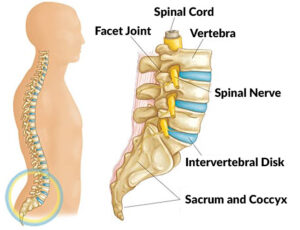Trans-sacral Interbody Fusion (AxiaLIF)
What to Expect
Once you have decided to have trans-sacral fusion surgery:
- A medical examination.
- Chest X-ray, EKG, and blood work.
- You may be asked to have a neurological or psychological examination.
- If taking aspirin or anti-inflammatory medications daily, stop these medications at least one week before surgery.
- If you take prescription medications or other drugs, including herbals, ask your doctor how soon before surgery you should stop taking these.
- You will be asked to use a home kit to perform an enema the evening before surgery.
- Do not have anything to eat or drink after the enema.
- You will check into the hospital the morning of surgery.
- Prior to the trans-sacral fusion surgery, you will be asked to sign permits for surgery, anesthesia, blood, and blood products.
The trans-sacral fusion surgery takes approximately 1-3 hours:
- An incision is made in the low back area just above the tailbone.
- Fluoroscopy (live X-ray) is used to guide the passage of a tube through the upper sacral vertebrae and into the lowest disc space.
- Instruments are passed through the tube and disc tissue is removed.
- A threaded cage is passed through the tube disc space.
- Bone graft is placed in the cage and disc space.
- Generally, pedicle screws are then placed to increase the stability of the operating segment:
- These may be placed using a minimally invasive technique.
- Generally, additional incisions are made in the area of the fused segment.
- Pedicle screws are placed into the bone above and below the fused segment.
- Rods are added to connect the screws.
You will be in the recovery room from 1 to 1½ hours:
- The surgeon will contact your family while you are in recovery.
- After going to a hospital room, you will be able to use a PCA pump to get medication for pain control. This machine controls the amount of medication that can be received.
- Staff will usually get you out of bed the same day as the surgery.
- The hospital stay is usually 1-2 days.
- A brace or corset is prescribed to restrict bending and promote healing of the fused area.
- You will be given any needed prescriptions and discharge instructions.
- A set of exercises that you can do at home will be provided.
- You will be able to ride in a car or plane upon leaving the hospital.
- It is important to avoid twisting and bending backward.
- Physical therapy is usually initiated after the first office visit with your doctor following the trans-sacral fusion surgery.
- Recovery from trans-sacral fusion varies greatly among patients and is dependent on the extent of the surgery as well as the age and health of the individual.
- Return to work also varies greatly among patients and is related to overall health and the type of work you do. It is important to note that back pain is seldom completely eliminated – the objective with trans-sacral fusion surgery is to reduce pain.


 Trans-sacral Interbody Fusion (AxiaLIF) is a surgical procedure in which the front part of the lumbar spine is fused from below.
Trans-sacral Interbody Fusion (AxiaLIF) is a surgical procedure in which the front part of the lumbar spine is fused from below.